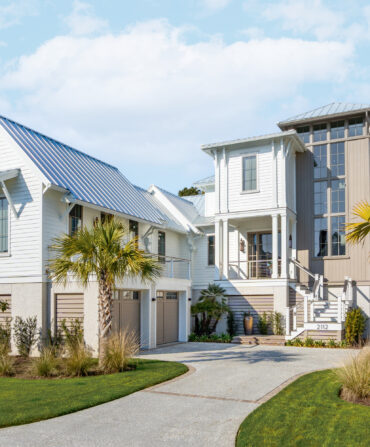Ab Atkins III riffles through a pile of yellowed photos on his kitchen countertop in Dallas’s Devonshire neighborhood. Here’s a photo of the house Atkins grew up in, a tidy columned affair amid the tall pines in Homer, Louisiana. One of the longleaf pine plantation that his great-great-granddad founded outside of Homer. There’s his daddy and his granddad Atkins, in bow ties and double-breasted suits with pocket squares. And there’s Ross Barnett, his other grandfather, an infamous segregationist governor of Mississippi, next to a photo of his mother, a teacher who, on the other hand, dedicated more than a decade to educating black students. (Atkins calls her “an incredible tribute to change.”)
Like many Southerners whose families bear legacies of both pride and pain, Atkins has learned not to ignore history, but to learn from it and build on it. The same could be said for his home. The wide white slab of marble where he spread the photos sits across from a wall of windows that looks out onto a narrow rectangular swimming pool that wouldn’t seem out of place in Palm Springs, California. A soaring glass wall in the living room frames a giant red oak in the front yard (Big Red, as Atkins calls it, his affection for the tree a nod to his rural childhood), and clerestory windows all around bathe the home in light. This is hardly a traditional Southern dwelling, but to Atkins, it’s a natural progression from his past.

Photo: Lisa Petrole
The floating staircase.
All around Devonshire, well-kept smaller homes have been razed in recent years and replaced, for the most part, by five-thousand-square-foot manses in classic architectural styles. Until a few years ago, Atkins lived in one such house in nearby University Park. In fact, he’d inhabited such classically styled homes all his life, going way back to the governor’s mansion in which he spent the first few months of his existence. His divorce changed all that, though, and when it came time to design a home for himself, Atkins felt himself pulled in a new direction. A commercial real estate developer who also runs his family’s various landholdings, including the old pine plantation, Atkins says he knows “just enough about design to be dangerous.” Rather than create an exact recipe for his dream home, though, he focused on the feeling the structure would evoke. When he decided on an architect, Will Clinton of the Dallas firm Clinton and Company Architects, Atkins gave him his directive: He wanted the warm embrace of a traditional Southern home, but with less formality—nothing fussy.

Photo: Lisa Petrole
The wet bar.
“It was so refreshing,” Clinton says. Whereas some clients come to him with specific looks and layouts in mind, Atkins wanted to create a mood. “I immediately started having images come to mind that weren’t necessarily about architecture. It was about warmth and texture and playing with proportion.” Acclaimed Dallas interior designer Jean Liu joined the effort early on, and the three started having weekly meetings to discuss everything from flooring materials to flow.

Photo: Lisa Petrole
The kitchen.
The result manages to be minimalist but welcoming, a Southern interpretation of a sleek aesthetic that can otherwise feel austere. Rough-hewn Texas limestone walls root the home in its environment. The floor tiles in the entry hall feature a matte gray finish and subtle creamy speckles for a come-on-in effect that doesn’t easily show dirt or shoe prints. In any other modern home, the floating staircase might be polished concrete, but here the treads are white oak stained to match the living room floor. A pair of large linen sofas across from the fireplace offers clean lines but also a clear invitation to lounge, to be at home.

Photo: Lisa Petrole
Prouvé standard chairs in the dining room.
Atkins’s new house revolves around two main focal points—the pool view and Big Red—and every part of the first floor directs the eye to one or the other. One of the most important architectural decisions, Clinton says, was to push the master suite wing forward toward the street and pull the living room wing back—thereby creating new angles from which to view the giant tree. Atkins’s favorite spot, a low-slung gray sofa in the expansive outdoor living room, affords views of both the pool and the tree, thanks to the wide-open spaces that create sight lines from one zone of the house to another. “Overall, you look through this house, not at it,” Atkins says. It’s a stark contrast to the more formally demarcated spaces in his former homes.

Photo: Lisa Petrole
The pool.
The art Liu chose for the house accomplishes a similar effect, most notably a large-scale Florian Maier-Aichen photograph above the fireplace that blends a mountainous landscape with distorted computer imaging, and an abstract Rosy Keyser canvas that’s the first thing one sees in the entry hall. A kind of collage of textures, the piece is intentionally torn and mended in places, and a wire protrudes from one side. “It really defies conventional art,” Atkins says. “People walk in and they have to stop and look at it from different angles.” He calls it the home’s “opening salvo,”an imperative to stop and look around. “I see it as powerful and thought-provoking. I see transformation.”

Photo: Lisa Petrole
A Florian Maier-Aichen photograph over the fireplace.
It’s not just the art that he’s talking about, and not just the home, but the magic that can happen when old ideas make way for new ones in a meaningful way. The first step is always a change in perception—in this case, of what a comfortable, welcoming Southern home can be. “I totally see things differently now, not just mentally but visually,” Atkins says of his home. “It’s crazy how that works.”

Photo: Lisa Petrole
From left: The master bedroom looks out onto the lush landscape; a painting by Patrick Groth in the master bathroom.








